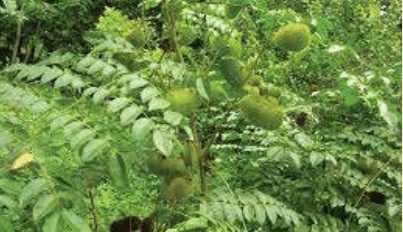
Caesalpinia bonduc (Fam. Caesalpiniaceae) is a prickly shrub with grey, hard, globular seeds and a smooth, shiny surface. It is commonly known as Bonduc nut, physic nut, yellow nicker nut, grey nicker nut, grey marble nuts, or fever nut in English. It is called yan yan dara in Hausa, ayóo or ruwo in Yoruba, nnamake or atak ake in Togo, and huka or eze-ogu among the Igbo in southeast Nigeria.
Constituents
The seeds contain significant chemical constituents, including triterpenoids, flavonoids, glycosides, saponins, amino acids, tannins, and alkaloids. Some amino acids in the seed kernel include aspartic acid, lysine, glycine, leucine, histidine, isoleucine, serine, butyric acid, tyrosine, and citrulline. The primary glycoside in fever nut is bonducin. The fatty oil from the kernel consists of stearic, palmitic, oleic, linolenic, and linoceric acids.
Preparations
Caesalpinia bonduc is available in the form of roots, leaves, fruits, and seeds, which may be used dried or as powders or pastes. The powder can be mixed with warm water, blended into a smoothie, or sprinkled over a salad.
Pharmacological actions and medicinal uses
Studies reveal that Caesalpinia bonduc has antipyretic, antibacterial, antidiarrheal, antihelmintic, antiasthma, anticancer, immunomodulatory, diuretic, antifungal, antifilarial, adaptogenic, and anxiolytic properties. Traditionally, fever nut powder mixed with pepper is used to treat indigestion and abdominal pain, while the seed paste is applied for skin ailments, particularly for hydrocele. In some medicinal practices, it is also used to treat leprosy.
The seed powder is traditionally used to expel worms, treat fever (especially malaria), relieve gum issues including boils and inflammation, alleviate cough and cold, ease indigestion, and address skin problems. It is also taken to promote liver health and treat liver disorders.
In gynaecology, fever nut serves as a uterine stimulant and is traditionally used to ease painful periods, manage polycystic ovarian syndrome, and cleanse the uterus after childbirth. Fever nut reduces oestrogen levels by inhibiting oestrogen secretion, which aids in managing polycystic ovarian syndrome.
Research shows that fever nut can inhibit mechanisms leading to asthma, block glucose absorption to reduce blood sugar spikes, and help relieve fever and inflammation, making it widely used in malaria treatment. It is also employed for skin diseases, boils, and wound care.
The water extract of the leaves effectively expels worms and treats diarrhoea. Studies on leaf extracts have shown reductions in tumour size, tumour cell volume, and cell count in rats with carcinoma. The leaves and juice or paste are used to treat smallpox, elephantiasis, liver diseases, and to reduce body odour. Fever nut is also beneficial in easing toothache.
Topically, fever nut paste helps relieve abdominal flatulence and testicular swelling from hydrocele and trauma.
Adverse effects
Due to its uterine contraction properties, fever nut is best avoided during pregnancy and breastfeeding.
Economic uses and potentials
Fever nuts are used in jewellery and various board games. The plant can also be cultivated as a live fence. Fifty grams of Caesalpinia bonduc or approximately 25 unpierced seeds cost $14.75. The oil extracted from the seeds is used in cooking and cosmetics. Fever nuts have commercial potential for cultivation, distribution, processing, and sales in the pharmaceutical, food, and cosmetics industries.
Email: ngozikaokoye@yahoo.com
References
Wild Turmeric (2019). 7 top medicinal uses and side effects of kalarchikai (fever nut). Available at: https://wildturmeric.net/kalarchikai-medicinal-uses-side-effects-health-benefits










